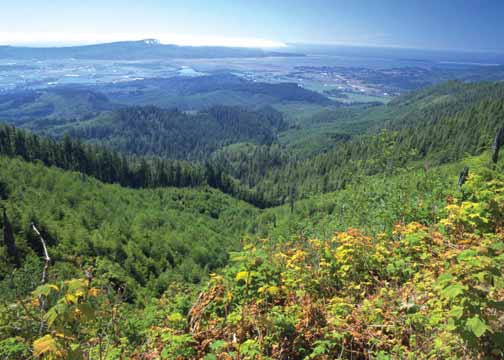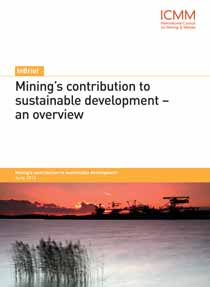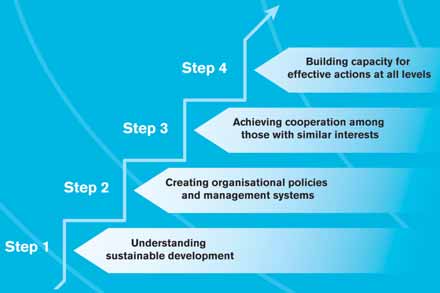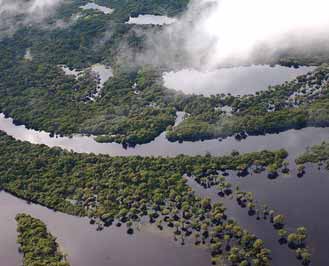The concept of sustainability continues
to gain traction in every industry, includ-ing mining. Even though mining typical-ly brings up ideas that conflict with the
tenets of sustainability, specifically
extracting non-renewable resources
from the earth, it is becoming more and
more possible to reconcile the two.
Sustainable mine reclamation en-sures that the surface of the earth is
not left to rejuvenate itself, thereby
mitigating potentially contaminated
and unusable land that previously lay
fallow for ages by past mining reclama-tion practices. Now, new uses for mined
land are being considered beforemin-ing even commences, and more oppor-tunities and emphases are being placed
on thinking about these future uses
with sustainability in mind.
Sustainable practices are growing in
popularity, and not just for altruistic
reasons. While these practices incorpo-rate the pace of a growing population
that is informed and active in ensuring
a thoughtful and careful approach to
natural resources, they can also simply
be more practical and fiscally sensible.
Simple Principle
This aspect of sustainability is often
unrecognized, but in fact the definition
of sustainability is much more pragmat-ic. The concept of sustainability is not
based on uncompromising idealism that
requires the land to be left untouched
by humans. In fact, the United States
Environmental Protection Agency de-scribes sustainability as “based on a
simple principle: Everything we need
for our survival and well-being depends,
either directly or indirectly, on our nat-ural environment. Sustainability creates
and maintains the conditions under
which humans and nature can exist in
productive harmony, that permit fulfill-ing the social, economic and other
requirements of present and future gen-erations. Sustainability is important to
making sure that we have and will continue to have, the water, materials and
resources to protect human health and
our environment.”
A new business model, commonly
known as the Triple Bottom Line, has
evolved from the sustainability efforts
pursued by progressive companies that
focus on technology, information and
new forms of value creation. The Triple
Bottom Line incorporates the three pillars of sustainability—financial prosperity, environmental stewardship and
social responsibility—and in this model
these pillars work together to simulta-neously influence business decisions.
By paying attention to the Triple
Bottom Line, organizations can effect
positive change that includes enhanced
public support, increased profitability,
reduced and better controlled risk,
minimized environmental impact, increased brand value and reputation,
and overall improved global standing to
operate and grow. Given all of these
positive outcomes, it stands to reason
that sustainable business models are
growing in popularity.
Once it is understood that sustain-able practices work to meet several
goals, it becomes easier to recommend
and implement such practices. Mine
reclamation can and should be re-examined from a sustainability frame-work. Especially given the current eco-nomic climate that has effectively nar-rowed the possibilities for viable mine
reclamation projects, incorporating sus-tainable practices in mine reclamation
will offer mineral producers financial,
environmental and social benefits.
While not always possible, greater
efficiencies can be realized if mine
operators think about the reclamation
process before mining even begins.
This allows for the possibilities of re-using certain materials and doubling
positive outcomes. Understanding the
natural footprint of the land to be
mined is also helpful toward achieving
sustainability goals—by being more
realistic about what the land can and
cannot accomplish once it is mined
will help to keep costs low and overall
production and post-production efforts
less arduous.
 Afforestation or reforestation of a mining area are both specific types of carbon offset projects well-suited for
Afforestation or reforestation of a mining area are both specific types of carbon offset projects well-suited for
sustainably reclaiming mined areas.
Identifying Specific Needs
In this line of thought, it makes sense
that there is a movement within sustain-able mine reclamation to return the land
to something not unlike its former self,
rather than attempting to create some-thing brand new and unrecognizable. In
many cases, this can be achieved by
working in concert with the local com-munity to determine what their needs
might be, and then repurposing the
mined site to meet those needs.
As an example, the community
surrounding a mined site may identify
a new neighborhood park as a local
need. By knowing this at the outset
of developing and/or reclaiming the
mined land, the organization and the
community can work together harmo-niously to determine the vision and
potential limitations of the project.
Other options a community might con-sider as helpful alternatives to a former
mined site could include a water reser-voir, viable industrial park, public
recreational trails through a reforested
area, or a similar project. For a mineral
producer that can develop a positive
relationship with the community in
which it operates, and can identify a
project that mutually benefits that
community as well as the producer,
more benefits abound. Good will and a
reputation for social responsibility go a
long way toward company growth and
market advantage.
In addition to partnering with the
local community, non-profit organiza-tions should be considered, as they
offer resources toward sustainable mine
reclamation projects as well. Working
with groups such as The Wildlife
Federation, The U.S. Fish and Wildlife
Service, The Nature Conservancy and other federal, state or local nongovern-mental agencies can help identify the
best possible end use for the reclaimed
mine—whether that be the creation of
habitats that encourage biological
diversity, endangered wildlife protec-tion, or an ecosystem that fosters the
growth of local but rare plant species.
These organizations can offer planning
and expertise, and can also help with
providing volunteer labor.
Additionally, partnerships between
mine operators and nongovernmental
organizations can provide economically
positive outcomes. These partner organ-izations offer grant funding and tax or
impact mitigation credits and incentive
knowledge that can help make a sus-tainable mine reclamation project that
much more financially feasible.
In addition to the options already
mentioned, another option for reclaim-ing mined land sustainably is by creat-ing a wetland bank. This could qualify
the land to generate wetlands credits.
In this scenario, a pre-approved wet-land bank would allow developers
and/or mine operators to secure wet-land mitigation credits for develop-ments that impact wetlands in other
locations. The credits finance the
development and maintenance of the
sustainably reclaimed mine as a wet-land bank. Once established, the wet-land bank could then be donated to a non-profit organization such as the U.S.
Army Corps of Engineers, the U.S.
Environmental Protection Agency, or
the U.S. Fish and Wildlife Service for
long-term maintenance and operation.
Carbon-offset opportunities are ano-ther sustainable end-use in the recla-mation of mined land. Carbon offsets
reduce carbon dioxide or other green-house gas emissions in a balancing act
to compensate for a carbon emission
made elsewhere. Companies, govern-ments and other organizations that
need to comply with carbon dioxide
caps make up one of the markets for
carbon offsets. Companies, govern-ments and individuals can also pur-chase carbon offsets to offset their own
greenhouse gas emissions that result
from everyday activities.
Afforestation and reforestation of a
mining area are both specific types of
carbon offset projects well-suited for
sustainably reclaiming mined areas. In
addition to the environmental benefits
these projects produce—improved air
and water quality, reduced soil erosion,
and a generally lessened impact of
global warming through carbon stor-age—afforestation or reforestation proj-ects can also offer new jobs, new
streams of revenue, and improved local
economies.
In one example, abandoned and
previously reclaimed coal mines in the
Appalachian region were reforested
through a project that brought together
the University of Kentucky, the U.S.
Forest Service and the Office of Sur-face Mining and Reclamation Enforce-ment. These sites proved excellent
locales for enhanced terrestrial carbon
sequestration.
Financial Rewards
Sustainably reclaiming a mine can also
benefit mine producers financially
through their eligibility for other tax
credits (especially the Brownfields tax
credit), and through an increased value
of the land. In one example, by trans-forming the land into an ecological
landscape that promotes long-term
preservation through land restriction
and charitable donation, the land qual-ifies for a tax credit that can offset cor-porate profits. This type of project will
also positively restore the land’s ecosys-tem, which will in turn increase the
overall value of the land. If the land is
then donated to the local community or
a charitable organization, a higher tax
credit for the land could be realized.
With the multitude of possibilities
available toward reclaiming mined
lands sustainably, it is no wonder that
sustainable mine reclamation is grow-ing in popularity. Sustainable mine
reclamation projects allow a mine pro-ducer to develop something new and
worthwhile, that supports the organiza-tion’s goals and the betterment of the
community in which they operate.
Sustainable mine reclamation projects
also create financial prosperity, envi-ronmental stewardship, and social ben-efits—thereby creating a positive Triple
Bottom Line for the producer, the com-munity and the environment.
Wendy Schlett is a project manager for
Sustainability, Environmental Management
Systems and Environmental Regulatory
Compliance at GZA GeoEnvironmental,
Inc. (www.gza.com). For more information,
contact Ms. Schlett at 616-956-6123 or
by email: wendy.schlett@gza.com.
ICMM Represents Mining at Rio+20
The mining industry demonstrates its commitment to sustainability
By Gina Tverdak-Slattery, Associate Editor
During the United Nations (U.N.)
Conference on Sustainable Develop-ment, Rio+20, held June 20-22 in Rio
de Janeiro, Brazil, senior U.N. officials,
world leaders, participants from govern-ments, the private sector, NGOs and
other groups, met to discuss how to
achieve global prosperity while protecting
the environment.
 The first of seven ICMM publications that describe
The first of seven ICMM publications that describe
mining and metals’ contribution to sustainable
development was released at the Rio+20 conference.
The event marked the 20th
anniversary
of the 1992 U.N. Conference on Environ-ment and Development and the 10th
anniversary of the 2002 World Summit on
Sustainable Development. During the
1992 Earth Summit, countries adopted
Agenda 21—a blueprint to rethink eco-nomic growth, advance social equity and
ensure environmental protection.
Rio+20’s 283-paragraph outcome
document “The Future We Want”
renewed countries’ commitment to sus-tainable development and called for a
wide range of actions. It focused on areas
that needed priority attention including
jobs, energy, sustainable cities, food
security and sustainable agriculture,
water, oceans, disaster readiness, as well
as reducing poverty and advancing gender equality.
Although serious policy discussions
unfolded at Rio+20, it concluded without
committing nations to any binding tar-gets on sustainability. Many countries
were left wondering what exactly a “green
economy” meant and many felt the final
document lacked detail and ambition.
But, despite the lack of commitments,
the mining sector shined with examples
of continuous improvement in sustain-ability over the course of 20 years.
Mining’s Contribution to
Sustainable Development
During Rio+20, the International
Council on Mining and Metals (ICMM)
launched the first in a series of seven
publications. The first publication,
“Mining’s contribution to sustainable
development: an overview,” describes
mining and metals’ contribution to sus-tainable development. Two other publi-cations were released during the confer-ence, while the remaining four will be
launched from July to November.
The ICMM was formed in 2001 to cat-alyze improved performance and enhance
the contribution of mining, minerals and
metals to sustainable development.
Today, it brings together 22 mining and
metals companies, as well as 34 national
and regional mining associations and
global commodity associations. ICMM
engages with governments, international
organizations, communities and indige-nous peoples organizations, investors,
civil society and academia. It works with
leading companies to strengthen the con-tribution of mining, minerals and metals
to sustainable development.
In many countries, mining and metals
activities are effectively managed to
ensure that a positive overall benefit is
achieved. But in some countries,
resources have been misused and squan-dered, fueling conflict and political
unrest. There have been disputes over
land use, property rights and environ-mental damage, concerns about revenue
transparency and corruption, and a grow-ing debate about the distribution of the
benefits of mineral wealth. Tensions
within communities and regions have
often been the result. And, in the
extreme, there has been conflict.
Mining is a key contributor to econom-ic growth and improved material quality of
life. With its need for both skilled and
unskilled labor, its links to regional infra-structure and service development as well
as the importance of the products that it
produces, means it can make a contribu-tion to sustainable development.
If well-managed, mining and metals
activities can provide lasting opportuni-ties for economic growth and develop-ment. ICMM believes society must con-tinue to improve the way it extracts,
processes and uses metals in order to
make a positive, long-term contribution
to people and the environment.
 Source: International Institute for Environment Development, 2012
Source: International Institute for Environment Development, 2012
Long-term Contributions
At the heart of the concept of sustainable
development lies the idea thatany human
activity, including mining, should be
undertaken in such a way that the activi-ty itself and the products produced pro-vide a positive long-term contribution to
human and ecosystem well-being.
ICMM believes the focus is not on how
mining can be sustainable but on how
mining, minerals and metals can con-tribute to sustainable development. The
industry has a key role to play in capturing
and communicating the full value of its
mining and processing activities and prod-ucts. This approach was first championed
by the Mining, Minerals and Sustainable
Development project in 2002, a project
that undertook a far-reaching examination
of industry practices and contributed to
the decision by leaders in the mining
industry to form ICMM.
Mine projects are a source of liveli-hood and well-being for millions of peo-ple. For emerging nations they attract for-eign direct investment, domestic invest-ment, foreign earnings and government
revenues. At the local level they provide
an opportunity for employment, provide
goods and services needed by mining
activities, and contribute to infrastruc-ture and services in the local community.
Often in remote areas, mining can
stimulate local economic activity.
However, local social and environmental
implications are significant and can
result in major socio-economic chal-lenges. When mismanagement occurs
(whether by government, company or
community), the resulting impact can be
adverse and severe. If a perceived or real
inequitable distribution of costs, bene-fits, risks and responsibilities occurs,
tensions can split a community, under-mine a company’s reputation and at
worst, lead to conflict.
While minerals and metals provide a
material foundation for contemporary
society, they are also a means for trans-forming current society into one marked
by greater efficiencies, lower environ-mental stresses and more effective pub-lic services. Just as the businesses that
produced them must be carefully man-aged, so too should the contribution
these products can make to en-sure that the benefits from their usage
are realized.
Change and Progress in the
Mining and Metals Industry
Achieving positive change in the mining
and metals industry so it can adjust to its
evolving operating environment is a sig-nificant challenge for those inside and
outside the sector. When managed
responsibly and effectively, and in a con-text of good governance, mining and met-als production can contribute meaning-fully to an improvement in living stan-dards, particularly in communities direct-ly impacted by these operations.
In the late 1990s, CEOs from some of
the world’s leading mining companies
launched an effort to reposition the
industry in terms of both performance
and perception. Faced with a ground-swell of public criticism, it commis-sioned the International Institute for
Environment and Development (IIED) to undertake a global review of practices
and develop an agenda for strengthening
the industry’s contribution to sustainable
development. Some 50,000 people from
around the world participated in the
resulting process that came to be known
as the Mining, Minerals and Sustainable
Development (MMSD) project. Out of
that review emerged an agenda for
change to strengthen the contribution of
mining, minerals and metals to sustain-able development. ICMM was created in
2001 to facilitate delivery of that agenda
working with its members and others in
pursuit of continuous performance
improvement.
From an ICMM perspective, the fol-lowing 10 indicators highlight how the
industry has changed markedly over the
past decade.
1. Reporting and assurance: Among
leading companies there is now full
acceptance and familiarity with annual
reporting of performance against sustain-able development principles using an
independent third-party assured process.
There has also been a steep increase in
interest on the part of investors in the
social and environmental performance of
mining and metals companies, as well as
the development of initiatives such as
the Equator Principles and the IFC
Performance Standards.
2. Mining and development: More and
more developing and emerging nations
are finding that the role of mining and
metals in their national economies can
be a positive factor, that their dependen-cy on mining and metals for economic
strength is growing and that mining and
metals can play a key role in addressing
poverty reduction and other develop-mental issues. Companies are accepting
this developmental role, though the
boundaries of responsibility between
company, community and government
remains a concern.
3. Revenue transparency: Today’s
support for enhanced revenue trans-parency, as reflected in the commitment
by governments, companies, investors
and civil society organizations to the
Extractive Industries Transparency In-itiative, did not exist a decade ago.
4. Human rights: The committed focus on human rights by mining compa-nies has increased significantly in the
last decade, and the industry is now con-sidered to be one of the leaders though
many significant challenges remain.
5. Environment: Environmental man-agement systems with a substantive
focus on performance related to critical
issues such as biodiversity protection and
water management are now accepted pri-orities of most mining companies.
6. Health and safety: Clear progress
on the introduction of systems that
emphasize a health and safety culture.
Significant reductions in lost-time injury
incidents year-on-year have been
achieved as well as similar improvements
in occupational health. The industry still
faces the challenge of eliminating fatali-ties in work-related accidents.
7. Climate change: The mining and
metals industry’s committed entry into
the climate change arena through
engagement at the country level by both
companies and national associations,
regional association engagement in
Europe and ICMM’s championing of a
generic set of principles for guiding the
development of climate change-related
public policy, represents a significant
change. Closely linked to this is ongoing
work on enhancing energy efficiencies, reducing carbon emissions contributing
more effectively to local energy needs,
and recognizing the role of minerals and
metals in a low carbon economy.
8. Relationship building and shared
value: The industry’s recognition of the
importance of relationship building
and the creation of shared value—for
communities, companies and govern-ments—reflects a dramatic change
to previous business approaches.
Unfortunately, there are many locations
where this degree of trust does not exist.
9. Full project life cycle, long time
horizon: Recognition by the industry,
communities, civil society and govern-ment to consider the full project life
cycle—from exploration through to the
long post-closure period—in a mine’s
design and financial analysis reflects a
major evolution. The impact of this life
cycle approach on a project’s technical,
financial, environmental and social out-comes remains to be seen. Addressing
legacy and orphaned sites is being
resolved slowly in most countries.
10. Sustainability footprint and tracking responsible performance across the
full life cycle: Initially driven by concerns
over illicit support of factions in conflict
areas (blood diamonds), the increased
interest in tracking performance across
the full product life cycle of metal and
metal products, has resulted in a strong
focus on life cycle assessment. The
development of an integrated “sustain-ability footprint” would not have been
considered necessary a decade ago.
Mining and metals operations bring
significant change—social, environmental
and economic. According to ICMM, its
series of publications is recognizing the
role of the industry as an agent of change.
They begin to describe the design and
performance criteria needed to ensure
that the net result of the industry’s impact
is positive over the long term.
Seven Questions to Sustainability
1. Engagement
Are engagement processes in place and working effectively?
2. People
Will people’s well-being be maintained or improved?
3. Environment
Is the integrity of the environment assured over the long term?
4. Economy
Is the economic viability of the project or operation assured, and will the economy of the community and beyond be better off as a result?
5. Traditional and non-market activities
Are traditional and non-market activities in the community and surrounding area accounted for in a way that is accept-able to the local people?
6. Institutional arrangements and governance
Are rules, incentives, programs and capacities in place to address project or operational consequences?
7. Synthesis and continuous learning
Does a full synthesis show that the new result will be posi-tive or negative in the long term, and will there be periodic reassessments?
Source: MMSD North America, 2002.
|
 In its reforestation efforts for the Juruti bauxite mine, Alcoa is using a natural
In its reforestation efforts for the Juruti bauxite mine, Alcoa is using a natural
method that is more efficient, cost-effective and sustainable than traditional
reforestation methods. (Photo courtesy of Alcoa)
Alcoa Bauxite Mine Reforestation Done in a Natural Way
Alcoa is using a new, natural method for reforestation at its Juruti bauxite mine in Brazil that is efficient, cost effective and sustainable. The technique is based on the theory of nucleation, where small dense nuclei of plants and animals facilitate the arrival of other species. At Juruti, birds and other elements of nature are helping recover the soil rather than traditional reforestation, which works the soil and then
plant saplings.
“The nucleation method restores the environment in a short amount of time, leading to greater richness in biodiver-sity,” said Pedro Pinto, Alcoa Environment, Health and Safety manager for the Juruti bauxite mine. “It benefits the forma-tion of the soil by keeping the micro-environment more humid. This technique also reduces the need for using machinery, resulting in lower use of diesel oil and emissions.”
The natural nucleation approach to reforestation was created by Professor Ademir Reis of Brazil’s Federal University of Santa Catarina. Techniques used include arti-ficial shelters for animals; perches to attract birds and bats, which deposit seeds and help trees to germinate alone; lay-ing out seeds, roots, branches and small tree trunks to stim-ulate the natural regeneration of species, which attracts animals and creates a food chain in the restoration process; and ecological stepping-stones of small refuges for fauna inside crop plantations.
“The nucleation system is cheaper and ecologically more efficient because it makes the worked areas ‘look for’ its sus-tainability in a spontaneous way,” said Professor Reis. The Juruti bauxite mining area is among the first places in Brazil to use the nucleation method of environmental conservation. Alcoa began using the technique last August on a 175-acre (70 hectares) area there. In about two years, the area will have an understory favorable to the introduction of new species, like Brazil nut trees, andiras, trumpet trees, copaibas and others..
|




